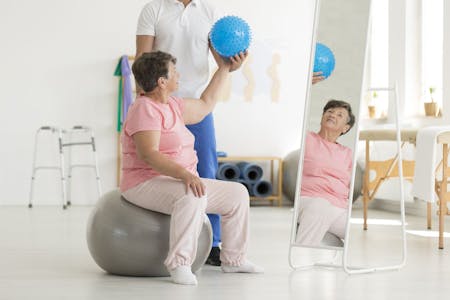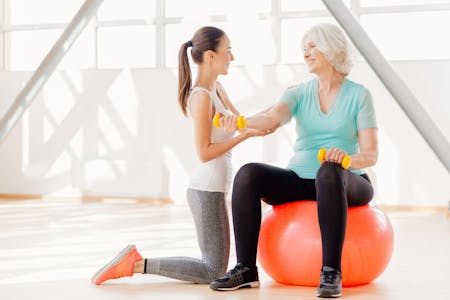Balance Disorders, Vestibular Rehabilitation and Physical Therapy

It is truly wondersome how most of us can stand and walk on two feet so easily. Our vestibular system is to be praised for this. It receives input from the inner ear, vision, and proprioceptive fibers in muscles and joints of the legs and spine, and helps us adjust our body, to maintain balance and avoid tripping over. But the sense of balance often called the sixth sense, does not always stay the same. It often gets affected by the disease, injury, or certain drugs, whose effects may or may not be long-term. It also gets deteriorated with age. Nonetheless, it can be improved or relearned with specialized training programs known as Vestibular Rehabilitation.
A balance disorder manifests as dizziness, vertigo, blurred vision, drunken gait, lightheadedness, the feeling of a fall, or an actual fall. These symptoms are unpleasant and can cause serious injury which is why it is best to consult a doctor for proper diagnosis and treatment. TruWell Physical Therapy provides rehabilitative services for balance disorders originating from conditions such as benign paroxysmal positional vertigo (BPPV), Meniere’s disease, concussion, etc. This article will be focused on the causes, symptoms, and physiotherapeutic management of these disorders.
Health Conditions That May Affect Balance
Concussion
A Traumatic Head Injury or a Whiplash Injury often leads to a concussion, where the brain is shaken within your skull, leading to some level of trauma to the brain. Such injury can occur during contact sports or motor vehicle accidents. The symptoms usually indicate the level of injury. The symptoms from a mild concussion don ‘t last for long and subside on their own. However, a medical checkup is important to rule out any danger signs, indicating severe injury, so as to avoid long-term effects with adequate treatment.
Signs and symptoms of concussion include: confusion, nausea, vomiting, slurred speech, slowed responses, brief loss of consciousness, vision and balance issues, and memory problems. These symptoms can appear right after the injury or within the next 24 hours.
Danger signs include: headache that keeps worsening, passing out, repeated vomiting, and seizures.
Ménière’s Disease
A buildup of fluid in the inner ear interferes with its hearing and balance function, giving rise to various discomforting symptoms such as vertigo, tinnitus, feeling of congestion, and loss of hearing. This buildup can be a result of an infection or injury, however, the absolute cause is unknown. The fact that this disease runs in family points to a genetic causative factor.
Ménière ‘s Disease usually affects only one ear. The symptoms are rather intermittent, arising for a short duration after several days. Some people experience severe dizziness that may even cause a fall. This condition is known as “drop attacks”.
Symptomatic treatment is provided to manage and reduce dizziness, which takes some trial and error, as treatment may work for one person but not the other. Surgery is used as a last resort, which involves decompression of the fluid-filled cavity.
Benign Paroxysmal Positional Vertigo (BPPV)
It is a balance disorder that is triggered by the movement of head, causing dizziness or vertigo. Its underlying cause is a mechanical error in the inner ear. In certain head positions, the ear sends false signals of movement of the head, that do not match with the visual stimuli, thus causing dizziness.
BPPV is a non-threatening condition with brief spells. There are no other associated symptoms such as headache, memory issues, etc. There is, however, one characteristic symptom of BPPV, which is nystagmus. It serves as a diagnostic criterion in testing tools for BPPV.
Things You Might Experience With Balance Disorders
The following list has some terms that are used interchangeably but the symptoms differ from one another. It is important to recognize the exact symptoms for successful management.
- Dizziness: It is a feeling of lightheadedness, faintness, and a false sense of movement of the head or surroundings.
- Vertigo: It is a specific type of dizziness in which the person feels as if the room is spinning around them.
- Tinnitus: In simple words, it’s called ringing of the ears. It is a false noise that sounds like a continuous bell ringing.
- Nystagmus: It’s the involuntary movement of the eyeball leading to vision deficits. The eye rapidly moves from side to side, up and down, in circles, or a combination of all.
Vestibular Rehabilitation: What to Expect
Vestibular dysfunction not only causes balance disorders but also negatively impacts your physical and mental health, as well as your social life. It affects your posture, causes anxiety and depression in anticipation of a vertigo spell, limits your social activities due to fear of injury, and pushes you towards a sedentary lifestyle. Although caution is needed for your safety, there ‘s no reason you cannot work towards the improvement of your condition and overall wellness.
Vestibular Rehabilitation is an exercise-based regimen to improve balance and treat the secondary health issues arising from balance disorders. The deficit due to a vestibular disorder is usually permanent as there is little to no restoration. However, it can be compensated by the usage of other senses. This compensation is spontaneously achieved by the brain as time passes, or it can be promoted through vestibular rehabilitation.
Vestibular Rehabilitation is customized to suit the person’s unique issues. Still, it is based on three basic principles:
- Habituation
- Gaze Stabilization
- Balance Training
Habituation exercise is designed to tackle the dizziness caused by movement of the head or what arises due to visual stimuli such as bright lights or repeated patterns. It involves controlled but repeated exposure to activities and stimuli that usually trigger the patient ‘s symptoms. With compliance the brain learns to ignore the stimulus completely, or to some extent, resulting in the reduced provocation of the symptoms.
Gaze Stabilization, as clear by the name, is aimed to improve the control of eye movements and reduce blurriness of the vision during head movement. It trains the brain to focus on a specific object whether it is static or moving, instead of the gaze jumping around.
Finally,
Balance Training includes physical exercises that strengthen the muscles and joints and help them stay steady. It usually involves the postural muscles that reside in your core, lower back, and legs. Balance training exercises start at a low difficulty level to mildly challenge the body. As it trains, the difficulty level can be increased by shifting from a plane surface to an uneven, or even a wobbly one. The more you train, the easier it will be to carry out daily life activities without assistance or without experiencing discomforting symptoms. Improvement in balance will also reduce your risk of falls and boost your confidence, ultimately increasing your participation in leisure activities.
Balance Retraining
Balance retraining is another concept in vestibular rehabilitation. Research shows that 75-80% of individuals with balance disorders seem to benefit from this method of training.
To describe in simple words, it is a method that helps you “reset” any changes in the vestibular system that may be causing consistent dizziness and imbalance. The basis of this technique is quite similar to habituation (i.e., repeated exposure, the stimulus being the things you struggle with). It starts with head movements and eye control exercises and leads up to daily-living activities that require more coordination. Read more about Balance Retraining at
vestibular.org



